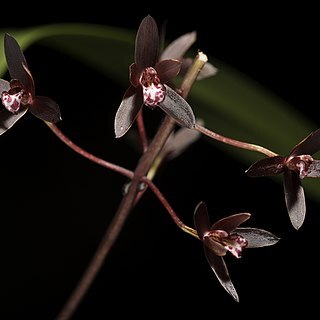Pseudobulbs 80–120 × 30–40 mm, grey-green to green. Leaves erect to spreading, 2–6 per pseudobulb, thick, rigid, fleshy, 300–500 × 30–40 mm, pale green to grey-green, curved, deeply channelled. Racemes 200–400 mm long, erect to drooping, 5–90-flowered. Flowers 25–45 × 20–40 mm, fragrant, extremely variable in colour (green, cream, pale green, greenish yellow, brown, purple, dull red, dark reddish black), usually blotched or striped in various combinations of colour and patterns. Dorsal sepal 15–25 × 7–10 mm. Lateral sepals 15–25 × 7–10 mm. Petals 13–22 × 5–9 mm. Labellum 15–20 × 8–10 mm, usually white with red markings, 3-lobed; lateral lobes erect, blunt; midlobe decurved, upper surface warty or hairy, with 2 hairy ridges.
More
An orchid which grows attached to trees. It produces thick fleshy bulb like organs. These are 3-12 cm long. The leaves are thick and smooth. They are leathery and V shaped. They are 10-50 cm long by 2-4 cm wide. The midrib is raised underneath. The flowers vary in colour. They can be green and yellow or red-brown. They are 1.5-4 cm long by 2-5 cm wide on stalks 20-40 cm long. These stalks come from the base of the bulb like structure. The fruit is a woody capsule. It is 4.5-5 cm long and about 1-1.7 cm wide. It splits along the edge when ripe. It contains many small seeds.
Widespread and common; mainly growing in drier forests and woodlands of W slopes of dividing range, adjacent semi-arid inland plains and, infrequently, extending to arid areas up to 600 km inland from the coast; it's less common in near-coastal areas where it occurs occasionally in littoral rainforests, monsoonal thickets and drier coastal forests (for example Stradbroke Island); in parts of the tropics, especially N.T. and W.A., it often grows on trees beside estuaries, coastal bays, and escarpments overlooking the sea.
More
It mostly grows on Eucalypts in open woodland. It grows in tropical and warm temperate places. It can withstand drought. It grows in drier areas. It grows in rotten logs.
An epiphytic plant, usually found in Eucalyptus forests. It grows on rotting wood in the hollows of trees in dry sclerophyll forest or woodland.

